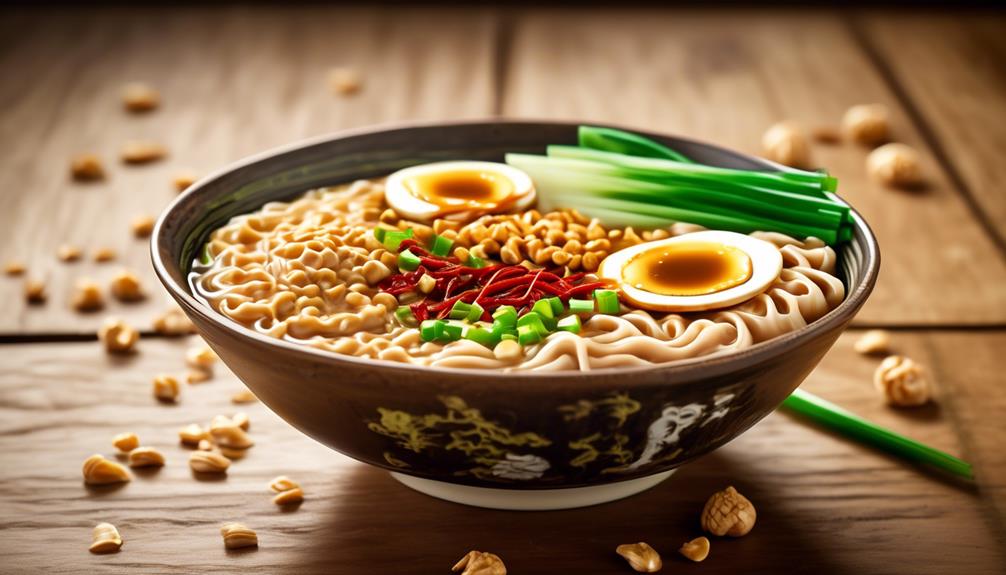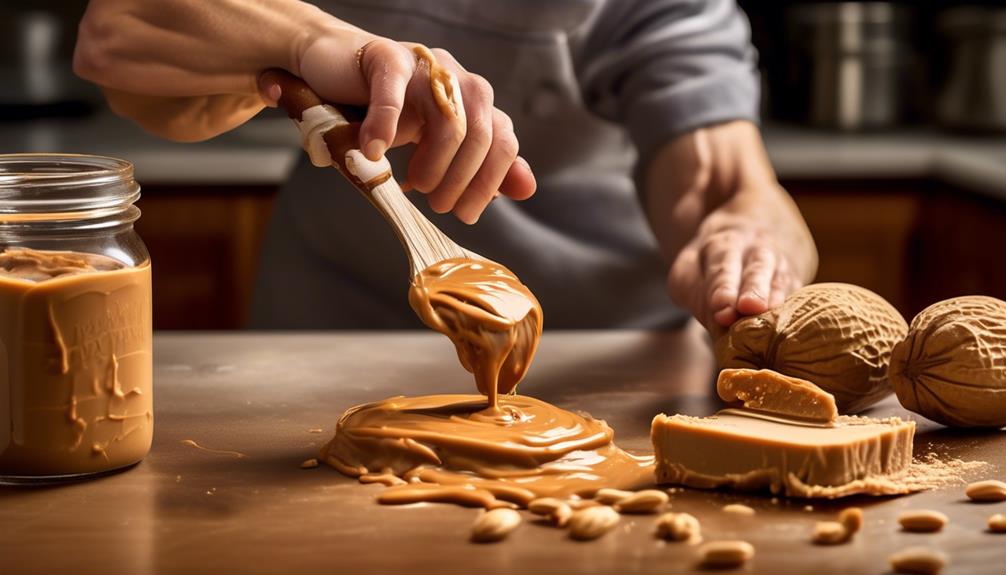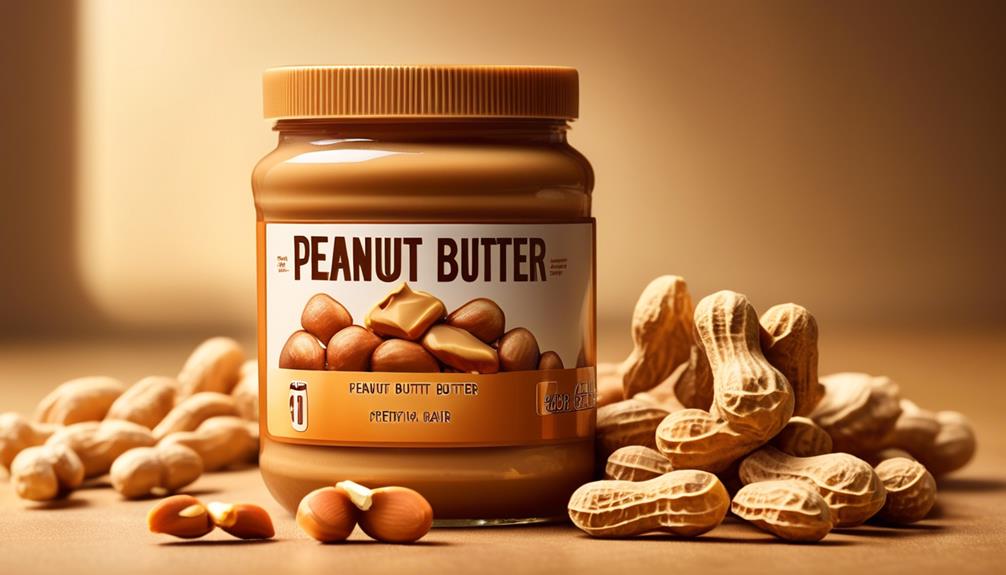Have you ever thought about how a basic bowl of ramen can turn into a flavorful dish with surprising tastes?
Well, making Peanut Butter Shin Ramen does just that. The fusion of creamy peanut butter and spicy gochujang or Sriracha chili sauce with the umami-packed Shin Ramen seasoning takes this humble dish to a whole new level.
But the real magic lies in the method of incorporating these ingredients to create a harmonious blend that elevates the ramen experience.
Stay tuned to discover the step-by-step guide to creating this unique and delightful Peanut Butter Shin Ramen that will surely leave your taste buds craving for more.
Key Takeaways
- Use natural-style creamy peanut butter for an authentic and robust peanut flavor.
- Gradually incorporate sesame oil and small amounts of broth to achieve desired consistency and richness in the broth.
- Experiment with complementary elements like garlic, lime, or chili garlic sauce to enhance the complexity of the peanut sauce.
- Carefully add Shin Ramen seasoning packets to the peanut butter ramen, adjusting the quantity or adding chili flakes for extra heat if desired.
Ingredients
For the peanut butter shin ramen, we typically use natural-style creamy peanut butter to achieve a robust peanut flavor in the dish. It's crucial to avoid heavily processed and sugared peanut butter to maintain the authentic taste of the recipe. The choice of peanut butter greatly influences the overall flavor profile of the dish, so opting for high-quality, natural-style peanut butter is essential.
In the absence of natural-style peanut butter, a suitable alternative is to use brown sugar to balance the sweetness in the peanut butter mixture. Additionally, incorporating chili garlic sauce can elevate the dish by adding heat, garlic, and acidity to the peanut butter ramen.
When making this peanut butter ramen recipe, it's important to consider personal preferences and customize the dish with variations such as a Peanut Lime Dressing or by adjusting the ingredients to suit individual taste preferences. The careful selection and balance of ingredients contribute to the rich and satisfying flavor of the peanut butter shin ramen, making it a versatile and delightful dish for any occasion.
Ramen Preparation

The careful selection and balance of ingredients in the peanut butter shin ramen directly impact the success of the dish.
Now, let's proceed to the ramen preparation, which is a crucial step in achieving the optimal flavor and texture.
- First, boil water in a large pot over medium-high heat to prepare the base for the ramen.
- Next, whisk together peanut butter, soy sauce, gochujang, and sesame oil in a large heatproof bowl to create the flavorful and spicy peanut butter mixture.
- Then, cook the ramen noodles in the boiling water for about 3 minutes, drain them, and remember to reserve 1 cup of the cooking water.
- After that, whisk the reserved hot cooking water into the peanut butter mixture and immediately add the hot noodles to coat with the mixture, ensuring that the flavors are evenly distributed.
These precise steps are essential in creating the perfect fusion of flavors and textures for the peanut butter shin ramen.
Adding Peanut Butter

When adding peanut butter to the ramen, it's crucial to consider the consistency of the peanut butter for optimal blending. The natural-style peanut butter offers a more pronounced peanut flavor, while processed and heavily sugared varieties may affect the balance of taste.
It's important to adjust the amount of peanut butter to align with individual taste preferences, ensuring that the flavor is harmoniously integrated into the dish.
Peanut Butter Consistency
To achieve the desired peanut butter consistency for the Peanut Butter Shin Ramen, experiment with the amount of peanut butter and other ingredients to suit your taste preferences. When adjusting the peanut butter consistency, consider the following factors:
- Use creamy peanut butter for a smoother texture in the ramen broth.
- Add sesame oil gradually to enhance the richness and creaminess without overpowering the peanut flavor.
- Balance the consistency by slowly incorporating small amounts of broth to ensure the desired thickness is achieved.
- Taste and adjust the seasoning as needed, keeping in mind that the ramen flavors will intensify as the dish simmers.
Peanut Butter Flavor
Experimenting with the addition of natural-style peanut butter is pivotal in enhancing the authentic peanut butter flavor in the Shin Ramen, ensuring a robust and savory taste profile.
When incorporating peanut butter into the ramen, it's crucial to opt for natural-style varieties to intensify the peanut flavor. Processed and heavily sugared versions may compromise the authenticity of the dish. If natural-style peanut butter is unavailable, consider adjusting the brown sugar in the recipe to maintain a balanced sweetness.
The inherent strong peanut flavor of natural-style peanut butter makes it an ideal choice for the dish. To further elevate the peanut butter flavor, one may also experiment with complementary elements such as garlic, lime, or chili garlic sauce. This amalgamation enhances the overall complexity of the peanut sauce, resulting in a more nuanced and satisfying ramen experience.
Mixing Peanut Butter
We can enhance the peanut butter flavor in the Shin Ramen by adding natural-style peanut butter, ensuring a robust and savory taste profile. When mixing peanut butter into the ramen sauce, consider the following:
- Use natural-style peanut butter for a stronger peanut flavor and avoid processed or heavily sugared varieties.
- If natural-style peanut butter isn't available, consider reducing the brown sugar in the recipe to balance the sweetness.
- Adjust the ingredients to suit your taste preferences, and consider making a non-spicy version by adding garlic and acidity separately or using a Peanut Lime Dressing as an alternative.
- Customize your peanut butter ramen with various proteins and vegetables, such as cooked chicken, shrimp, red bell pepper, spinach, and more, to create new flavor profiles.
Incorporating Shin Ramen Seasoning

First, we'll start by carefully adding the Shin Ramen seasoning packets to the peanut butter ramen, tasting as we go to achieve the perfect balance of spiciness and saltiness.
Then, we can consider adjusting the quantity of seasoning or incorporating additional chili flakes or hot sauce for extra heat if needed.
Seasoning Incorporation Tips
To achieve a harmonious blend of peanut, ramen, and sesame flavors in your dish, the following tips will be helpful:
- Gradually incorporate the seasoning into the peanut butter mixture. Stir continuously to ensure even distribution of flavors.
- Start with a small amount of seasoning and adjust to taste, as it can be quite potent.
- Dissolve the seasoning in a small amount of hot water before adding it to the peanut butter mixture. This will help with better dispersion of the seasoning.
- To avoid clumping, incorporate the seasoning slowly, ensuring it blends seamlessly with the peanut butter and other ingredients.
- Taste the mixture as you go and adjust the seasoning levels to achieve the desired balance of flavors.
These steps will ensure that the Shin Ramen seasoning is evenly distributed throughout the peanut butter mixture, creating a delicious and balanced dish.
Flavor Enhancement Techniques
Consider enhancing the flavor profile of your peanut butter Shin Ramen by skillfully incorporating the Shin Ramen seasoning to achieve a harmonious blend of savory and nutty notes.
Start by adding the seasoning packet to the boiling water before introducing the noodles, ensuring the flavors infuse thoroughly.
For an added kick, mix in a touch of chili sauce to elevate the spiciness and depth of the dish.
Additionally, sprinkle roasted sesame seeds over the ramen just before serving for a delightful crunch and a hint of nuttiness.
These flavor enhancement techniques will elevate the overall taste of your peanut butter Shin Ramen, providing a satisfying and flavorful experience.
Remember to adjust the seasoning and additional ingredients according to personal preferences to create a unique and personalized dish.
Balancing the Seasoning
To achieve a well-balanced flavor profile, carefully blend the Shin Ramen seasoning into the peanut butter mixture, ensuring a gradual incorporation to avoid overwhelming the dish.
When balancing the seasoning for Peanut Butter Shin Ramen, consider the following tips:
- Taste the sauce as you add the seasoning to avoid making it too salty or overpowering.
- Balance the umami and spiciness of the Shin Ramen seasoning with the richness of the peanut butter.
- Consider reducing the amount of soy sauce in the peanut butter mixture if the Shin Ramen seasoning is particularly salty.
- Experiment with small amounts of the Shin Ramen seasoning at a time to achieve the desired flavor without overwhelming the dish.
Mixing and Serving

Once the ramen noodles are cooked according to the package instructions, the creamy peanut butter, soy sauce, sriracha or gochujang, and toasted sesame oil should be mixed together in a separate bowl. This creates a rich, savory sauce that will coat the cooked noodles perfectly.
After draining the noodles, add them to the prepared peanut butter mixture. Toss the noodles until they're thoroughly coated with the flavorful peanut butter sauce, ensuring that each strand is infused with the delicious flavors.
To enhance the dish further, top the peanut butter ramen with chopped roasted peanuts for a delightful crunch, thinly sliced scallions for a mild onion flavor, torn fresh cilantro for a pop of herbaceous freshness, and a squeeze of lime juice for a zesty kick. These final touches will elevate the dish, adding layers of texture and brightness to the rich and creamy peanut butter ramen.
The dish is now ready to be served, offering a delightful harmony of flavors and textures.
Optional Additions

We can enhance the flavor and nutritional value of the peanut butter ramen by experimenting with different protein options such as cooked chicken, shrimp, or tofu.
Adding a variety of vegetables such as red bell pepper, spinach, shredded carrot, or edamame can further customize and add more texture and color to the dish.
To garnish the peanut butter ramen, consider using chopped green onions, cilantro, crushed peanuts, or sesame seeds, which add freshness and texture.
For a tangy kick, squeeze some lime juice over the prepared peanut butter ramen to enhance the overall flavor profile.
Nutritional Information

Enhancing the flavor and nutritional value of the peanut butter ramen can be further understood by examining its nutritional information, which sheds light on the protein, healthy fats, and carbohydrate content of its key ingredients.
Thai peanut butter is a good source of protein and healthy fats, providing a satisfying and nourishing element to the dish.
The instant ramen noodles, while convenient, are high in carbohydrates and sodium.
The addition of brown sugar adds sweetness but also increases the calorie and carbohydrate content.
Soy sauce contributes sodium and small amounts of protein, while sriracha sauce is low in calories but high in sodium and spice.
When preparing the ramen, using cooking water can help retain some of the nutrients from the ingredients.
It's important to be mindful of portion sizes and the overall balance of the meal to ensure that the dish aligns with individual nutritional needs.
Tips and Variations

Experimenting with different proteins and vegetables allows for a customized and varied peanut butter shin ramen experience. To enhance the dish, consider these tips and variations:
- Protein Variety: Swap out the traditional protein in your ramen for alternatives like grilled chicken, shrimp, tofu, or a soft-boiled egg to add different textures and flavors to the dish.
- Vegetable Additions: Consider adding a variety of vegetables such as sautéed mushrooms, spinach, or thinly sliced bell peppers to introduce new flavors and colors to your peanut butter shin ramen.
- Spicy Kick: For those who enjoy a bit of heat, try adding a drizzle of chili oil or a sprinkle of crushed red pepper flakes to give your ramen a spicy kick.
- Customized Ramen Sauce: Modify the ramen sauce by adjusting the amount of peanut butter or adding a splash of soy sauce to tailor the flavor to your preference.
Frequently Asked Questions
Can You Add Peanut Butter to Shin Ramen?
Absolutely, we can add peanut butter to Shin Ramen. It brings a rich, nutty flavor that complements the savory broth. Plus, it's a great way to customize your meal.
We recommend using natural-style peanut butter for a more intense taste. Adjusting the ingredients to personal preferences, such as reducing sugar if using natural-style peanut butter, ensures a perfect balance.
With added proteins and veggies, this dish becomes a wholesome delight.
How to Add Peanut Butter to Ramen?
Absolutely, adding peanut butter to ramen is a game-changer.
We mix natural-style peanut butter, soy sauce, gochujang or Sriracha, and toasted sesame oil.
Cook the ramen separately and toss it in the peanut butter mixture, using reserved cooking water for the right consistency.
Add proteins like chicken, shrimp, or tofu and various vegetables for flavor and nutrition.
Garnish with roasted peanuts, scallions, cilantro, and lime wedges to elevate the dish.
Does Peanut Butter Make Ramen Better?
Peanut butter can enhance the flavor and texture of ramen, making it creamier and adding a hint of nuttiness. It's a versatile ingredient, allowing for customization with various proteins and vegetables.
However, it's important to use natural-style peanut butter without excessive sugar. Adjusting the recipe to personal taste, like using honey for sweetness, can elevate the dish.
Serving with steamed or pickled vegetables and garnishing with crushed peanuts adds extra dimension.
What Can I Add to Shin Ramen to Make It Better?
To make Shin Ramen better, we can experiment with different proteins and veggies like chicken, shrimp, red bell pepper, or spinach. Adjusting the recipe to personal taste preferences is key, for example, using almond butter instead of peanut butter or honey instead of brown sugar.
Garnishing with chopped green onions, cilantro, or crushed peanuts adds freshness and texture. Additionally, consider using different flavors of ramen like shrimp, beef, or veggie for variety.
Conclusion
Once the Peanut Butter Shin Ramen is prepared and served with the optional toppings, it's time to enjoy this delicious and satisfying dish.
The creamy peanut butter, spicy gochujang, and savory soy sauce create a perfect balance of flavors, while the added protein makes it a hearty meal.
With just a few simple ingredients and easy steps, this recipe is a convenient and flavorful way to enjoy a bowl of ramen.









